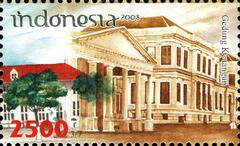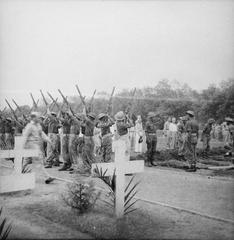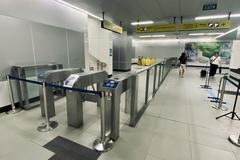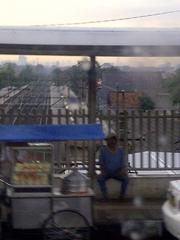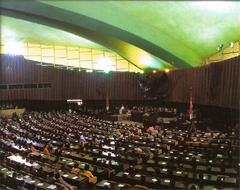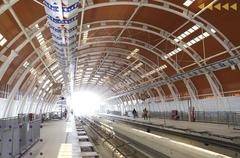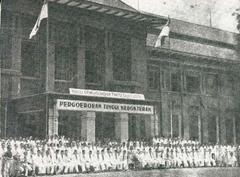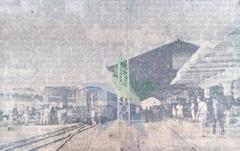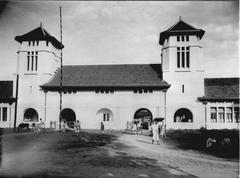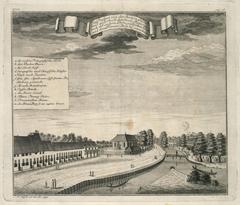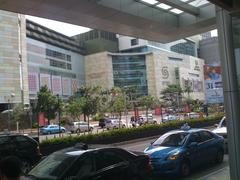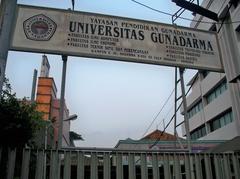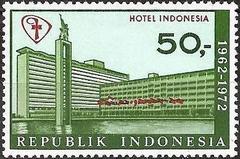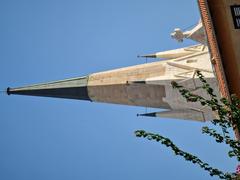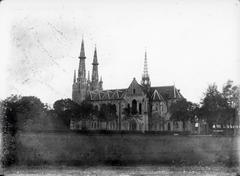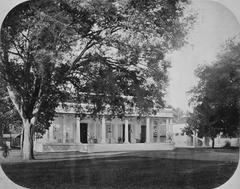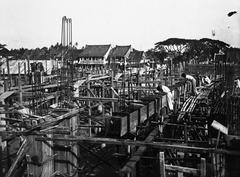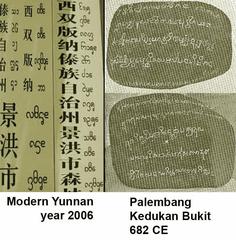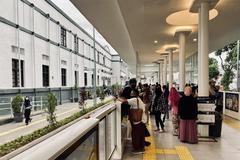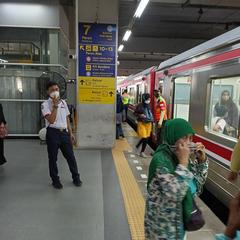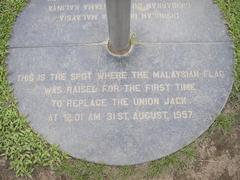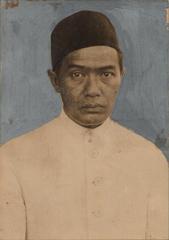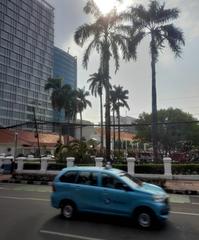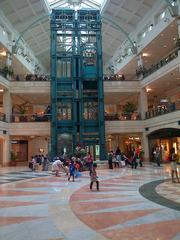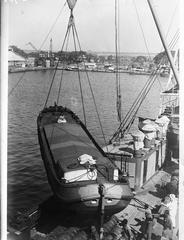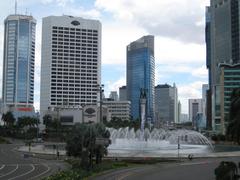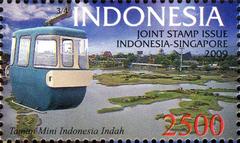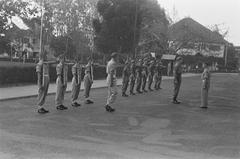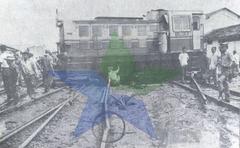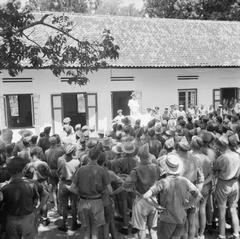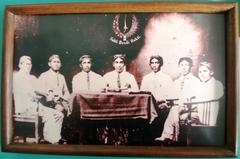Amsterdam Gate Jakarta: Visiting Hours, Tickets, and Historical Significance
Date: 04/07/2025
Introduction
Nestled in the historic Kota Tua district, the Amsterdam Gate (Gerbang Amsterdam) was once a prominent symbol of Dutch colonial power in Jakarta. Though the original gate was demolished in the 1950s, its legacy continues to inform the city’s heritage, urban landscape, and cultural consciousness. This comprehensive guide explores the Amsterdam Gate’s history, its role in Batavia, current visitor information, nearby attractions, and the ongoing efforts to preserve Jakarta’s colonial-era landmarks. Whether you are a history enthusiast or a curious traveler, understanding the Amsterdam Gate deepens your appreciation of Jakarta’s layered past.
Table of Contents
- Historical Overview
- Visiting the Amsterdam Gate Site Today
- Cultural Significance and Preservation
- Frequently Asked Questions (FAQs)
- Plan Your Visit: Practical Tips
- References
Historical Overview
Origins and Construction
The Amsterdam Gate (Dutch: Amsterdamse Poort, Indonesian: Gerbang Amsterdam) was constructed in the 17th century as part of the fortified Dutch East India Company (VOC) Castle in Batavia, now Jakarta. Serving as the main southern entrance to the castle, the gate was strategically located near the bustling Sunda Kelapa Harbor, connecting the administrative heart of the city with its commercial port (Indonesia Dutch Colonial Heritage).
Architectural Features and Symbolism
Originally designed in the Dutch Baroque style, the gate featured robust masonry, arched passageways, and ornate statues of Mars and Minerva—symbols of military strength and wisdom. Decorative urns and Rococo flourishes reflected European influences, while the imposing structure projected colonial authority over Batavia’s multicultural population (Wikipedia: Amsterdam Gate, Jakarta).
Role in Batavia
The Amsterdam Gate was more than an architectural landmark; it functioned as a hub for administration, justice, and military activity. It marked the boundary between the VOC’s European quarters and the surrounding local settlements. The gate witnessed processions, public gatherings, and the daily movement of traders, officials, and townspeople, symbolizing both opportunity and control within the colonial system (The Crazy Tourist).
Decline and Demolition
Following the decline of the VOC and the gradual dismantling of the castle between 1798 and 1810, the Amsterdam Gate lost its strategic importance. Partial demolitions occurred in the 19th century to accommodate horse-drawn trams and urban expansion. Its final removal in 1950 reflected the post-independence drive to modernize Jakarta and move beyond colonial-era symbols (Lost Jakarta).
Visiting the Amsterdam Gate Site Today
Location and Accessibility
The former site of the Amsterdam Gate lies at the intersection of Jalan Cengkeh and Jalan Nelayan Timur in Kota Tua, West Jakarta, about 400 meters north of the Jakarta History Museum (Museum Fatahillah). The area is easily accessible via TransJakarta buses, commuter trains (KRL) to Jakarta Kota Station, and taxis (Backindo).
Visiting Hours and Ticket Information
- Hours: Kota Tua is open daily from 8:00 AM to 6:00 PM; however, the Amsterdam Gate site itself is a public street and accessible at any time.
- Tickets: There is no fee to visit the Amsterdam Gate site. Nearby museums, such as Museum Fatahillah, may charge admission (typically IDR 5,000–20,000).
Guided Tours and Visitor Tips
- Guided Tours: Numerous walking tours explore Kota Tua’s colonial landmarks, often including the former Amsterdam Gate site and stories about its history. Booking ahead is recommended, especially on weekends.
- Visitor Tips: Wear comfortable footwear and sun protection, as the area is pedestrian-friendly but may have uneven surfaces. Early mornings or late afternoons are best for avoiding crowds and heat.
Nearby Attractions
- Jakarta History Museum (Museum Fatahillah): Showcasing artifacts and exhibits from Jakarta’s colonial era.
- Wayang Museum: Dedicated to traditional Indonesian puppetry.
- Museum of Fine Arts and Ceramics: Exhibiting Indonesian art and ceramics.
- Kali Besar Canal: Picturesque canal lined with Dutch colonial buildings.
- Cafe Batavia: A historic café offering colonial-era ambiance and refreshments (Museum of Wander).
Cultural Significance and Preservation
The Amsterdam Gate stands as a symbol of Jakarta’s transformation—from a walled colonial outpost to a vibrant, modern metropolis. Its demolition in the 1950s was part of a broader movement to redefine Indonesia’s urban identity after independence, often at the expense of colonial relics. Today, debates continue over whether to reconstruct the gate or preserve its memory through museums and educational initiatives (Lost Jakarta; Wikipedia: Amsterdam Gate, Jakarta).
Ongoing revitalization efforts in Kota Tua highlight the value of heritage preservation for education, cultural tourism, and community pride. The absence of the Amsterdam Gate reminds visitors of the complexities of heritage management in rapidly modernizing cities (Indonesia Travel Hub).
Frequently Asked Questions (FAQs)
Q: Can I visit the Amsterdam Gate today?
A: The original gate was demolished in the 1950s. However, you can freely explore its former site within the Kota Tua district.
Q: Are there any remnants or markers of the Amsterdam Gate?
A: No physical traces remain, but historical maps, photographs, and museum exhibits provide visual context.
Q: Is there a fee to visit the site?
A: No, the site is free. Some nearby museums may charge admission.
Q: Are guided tours available?
A: Yes, many walking tours of Kota Tua include the Amsterdam Gate’s history.
Q: What is the best time to visit?
A: Early mornings or late afternoons are ideal to avoid crowds and enjoy the area’s ambiance.
Q: Are there plans to reconstruct the Amsterdam Gate?
A: While proposals have been made, as of July 2025, no reconstruction has taken place (Wikipedia: Amsterdam Gate, Jakarta).
Plan Your Visit: Practical Tips
- Getting There: Use public transportation to Jakarta Kota Station or TransJakarta bus routes to Kota Tua.
- Walking Tours: Both guided and self-guided tours are available online (Museum of Wander). Maps and digital guides enhance the experience.
- Facilities: The area offers restaurants, cafés, bicycle rentals, and public restrooms.
- Safety: Watch for traffic near the old gate site and keep valuables secure.
Visual Resources
For a richer understanding, explore archival photographs and historical maps available in local museums and online archives (Indonesia Dutch Colonial Heritage). Virtual tours and interactive maps provide immersive experiences of Kota Tua’s colonial heritage (Indonesia Travel Hub).
Conclusion
Though the Amsterdam Gate no longer stands, its legacy endures in the collective memory and cultural fabric of Jakarta. Visiting its site within Kota Tua allows you to walk through centuries of history, experience the city’s dynamic past, and participate in the ongoing conversation about heritage, identity, and urban development. For more updates and curated tours, download the Audiala app and follow us on social media to enrich your exploration of Jakarta’s historic heart.
References
- Indonesia Dutch Colonial Heritage
- Wikipedia: Amsterdam Gate, Jakarta
- The Crazy Tourist
- Lost Jakarta
- Indonesia Travel Hub
- Museum of Wander
- Backindo
